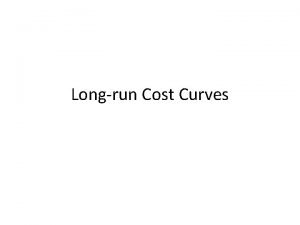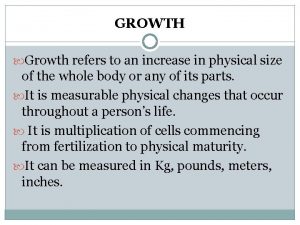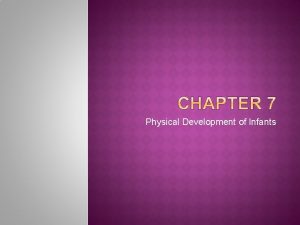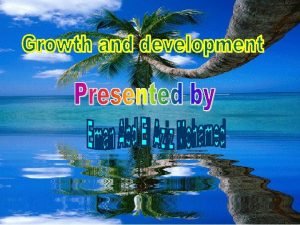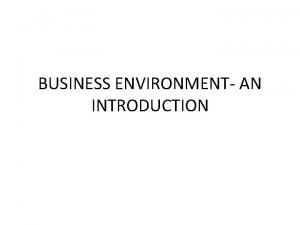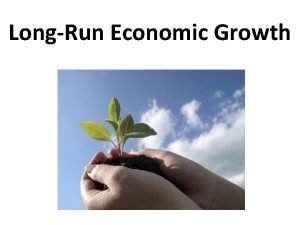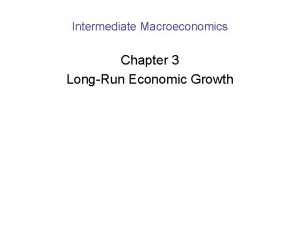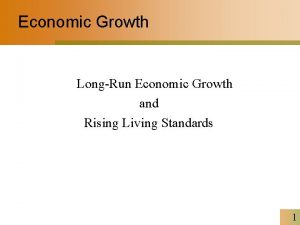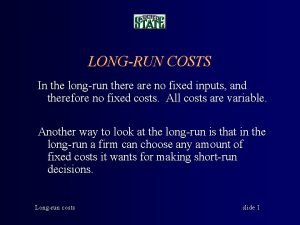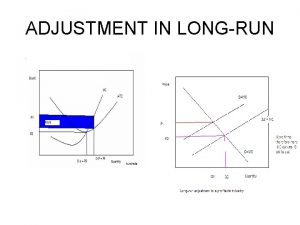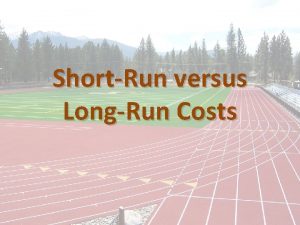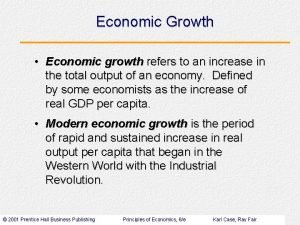LongRun Economic Growth 1 The economic growth refers










- Slides: 10

Long-Run Economic Growth 1

§ The economic growth refers to a sustainable increase in economic activity. § Technically, either § Real GDP per capita § Real GDP per employed worker § It is in low % but over long term low % matter a lot § “rule of 70” 2

§ What’s good about economic growth? § Have more of everything § Material stuff § Or other stuff, too § Alleviation of poverty § Poverty hurts less if you have more § Redistribution is possible § Redistribution may be easier (helping others is a luxury) § Cost of economic growth § Opportunity cost = … § Value of today’s consumption 3

§ Where does economic growth come from? § Recall, Y = (factor quantity) x (factor utilization) x (factor productivity) § factor utilization is a short-run concept § The other two are long-run § Land is pretty much fixed § Capital § Increase in quantity § Increase in quality § Labour § Increase in quantity § Increase in quality (Human capital) § Technological advances 4

§ National accounts again: § The simplest model, Y = C + I § or, S = I § We implicitly endogenize interest rate in the model § § § Expand a bit: Y=C+I+G Define: Y – T – C = private savings T – G = public savings Then NS = (Y-T-C) + (T-G) = Y – C – G 5

§ The interest rate and the loanable funds The real interest rate an consumption The real interest rate private savings The real interest rate and public savings The real interest rate and rate of return The real interest rate and profitable investment projects § The real interest rate and investments I § § § The long-run equilibrium: § NS*(r*) = Y* – C – G = I*(r*) 6

§ Comparative statics of growth: § Higher national savings = higher growth § encourages investments § Higher investment demand = higher growth § encourages savings § Empirical support is OK 7

§ Neoclassical growth model (Solow) § Aggregate production function § Y = AF(L, K, H) § Diminishing marginal returns § Constant returns to scale 8

§ What grows and how? § L grows: § GDP grows § GDP per capita declines § H grows: § GDP grows § GDP per capita grows at diminishing rate § K grows: § GDP grows § GDP per capita grows at diminishing rate § Balanced growth: § L goes up and K goes up § (constant return to scale ) => GDP per capita = const 9

§ What grows and how? § Technology improves § GDP grows § GDP per capita grows § § § Embodied technical change Disembodied technical change (revolution!) Solow residual A (total factor productivity TFP) “New” growth theories “Limits” to economic growth 10
 Longrun cost
Longrun cost Economic growth vs economic development
Economic growth vs economic development What is economic growth and development
What is economic growth and development Synchronous growth
Synchronous growth Growth refers to
Growth refers to An infant's growth refers to changes in
An infant's growth refers to changes in Durganand sinha ecological model diagram
Durganand sinha ecological model diagram Cephalohematoma vs caput succedaneum
Cephalohematoma vs caput succedaneum Transaction exposure vs economic exposure
Transaction exposure vs economic exposure Internal business environment factors
Internal business environment factors Voi kéo gỗ như thế nào
Voi kéo gỗ như thế nào
